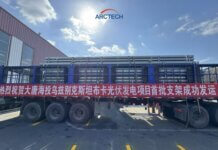Established in 1864, McCarthy Building Cos. is expanding its work in the solar industry. The company was looking to enhance its piling capabilities and improve its accuracy and pile installation productivity. The building company also wanted to minimize rework, improve staff utilization and eliminate downtime waiting on surveyors.
To date, the company has completed over 35 utility solar plants, generating 2 GW of solar power. Typical pile installation on a utility-scale solar project starts with a professional survey, usually completed by a two-person crew, marking tracker end-pile points at the solar field.
The tracker device mechanically moves solar modules to an angle that aligns with the sun’s position throughout a day. The tracker system also includes the piles, torque tubes and rack system. The tracker position is critical, and it requires mechanical installation with a pile driver for precision and stability.
Following traditional manual methods, after the survey crew marks the position of where the piles need to be installed, the layout team – typically consisting of three or four crew members – pulls the string lines and plants markers to indicate where the piles should go. The shakeout crew consists of another three or four people to distribute the materials required for install. The shakeout crew arranges the piles, ensuring they’re facing the right way and that the correct-sized piles are staged at the proper location. They mark piles with a specific color by size for quicker distribution according to the layout.
For pile installation, the machine operator walks beside the pile driver machine, operates the pile driver and logs data accordingly. From there, another crew member checks the pile type, moves the pile to the target, straps the pile to the machine, assures proper position and installs the pile.
Josh Marriott, senior virtual design construction (VDC) field solutions engineer for McCarthy, explains that the traditional process of pile installation is manual and extremely costly. Accuracy can also be an issue on a typical project. In fact, 4%-5% of piles need to be reworked on most projects, which adds up to significant costs.
“Before you even start to install piles on a solar project, you’re using eight to 10 people,” says Marriott. “We wanted to find ways to cut our labor needs, improve production and accuracy of the crew, and improve the quality of our work. Our SITECH Tri-Rivers dealer and Trimble were up to this challenge.”
Building a 3D pile plan and new workflow
Trimble and SITECH Tri-Rivers started by installing Trimble’s DPS900 Piling System on one GAYK hydraulic ram piling machine. They chose a 400-acre utility-scale solar field project in Millington, Tenn., with 31,000 piles to install as their pilot project.
To test the new equipment and process, they drove 40 piles to start. The results were impressive, with the worst pile being off target by only one-quarter of an inch. Pleased with the results, they installed the equipment on two additional machines and started training their VDC team on the new workflow, leveraging Civil 3D and Trimble Business Center.
Trimble Business Center allows users to process and prepare geospatial data so it can be read by the DPS900 system. The operators access the pile plans from the on-board displays, line up the piling machine according to the design and drill for the pile. Operators can then view completed piles compared against planned piles in both 2D and 3D views.
3D guidance delivers ROI
Jon Wieneke from SITECH Tri-Rivers helped the McCarthy team create a piling plan for the Millington solar project, assigning all 31,000 piles. Wieneke configured the piles and devised a pile plan leveraging the pile description, which includes pile length, elevation, required embedment depth and alignments. At the same time, he also created customized pile plan templates for McCarthy to use on additional solar projects, as well. Wieneke used the feature code manager within Trimble Business Center for importing surface details and pile points into the software and then exported the plans to the Trimble DPS900 systems.
After a learning curve that lasted for approximately 2,000 piles, operators began to fine-tune issues and followed the pile plan to drive several hundred piles per day. After about one week, the foreman and operator became more comfortable with the Trimble DPS900 system, and the team began to see positive results. The McCarthy team also succeeded in cutting rework required for pile placement to below 5% of total piles placed.
Using this 3D machine-guided approach, McCarthy reduced the labor required for prep and pile installation by more than 50%, reducing the crew required from 12 people to a crew of three or four people. They were also able to install hundreds of piles per day, keeping pace with an aggressive schedule of three months, even with weather delays.
“We noticed that overall, our piles were straighter than they’ve ever been using more manual methods, and we were able to see significant advantages of reducing the labor required in the field,” says Marriott. “We also generally budget around $250,000 for survey costs for a solar project of this size, but now we’re minimizing those costs, too.”
Marriott adds that he sees the biggest benefit of leveraging the DPS900 system for solar projects where 10,000 or more piles need to be installed, or for sites more than 20 MW.
While some of the survey budget was re-allocated for the VDC team to build out the pile plan, Marriott believes that overall, his team significantly reduced costs with this new process.
“In other ways, we are also cutting time and money out of the schedule because we’re not waiting on the survey team; we do not have to stop work for layout tasks or to check our work because we’re confident it’s right,” he says.
Rebecca Muhlenkort is a freelance writer covering the geospatial and construction industry.




